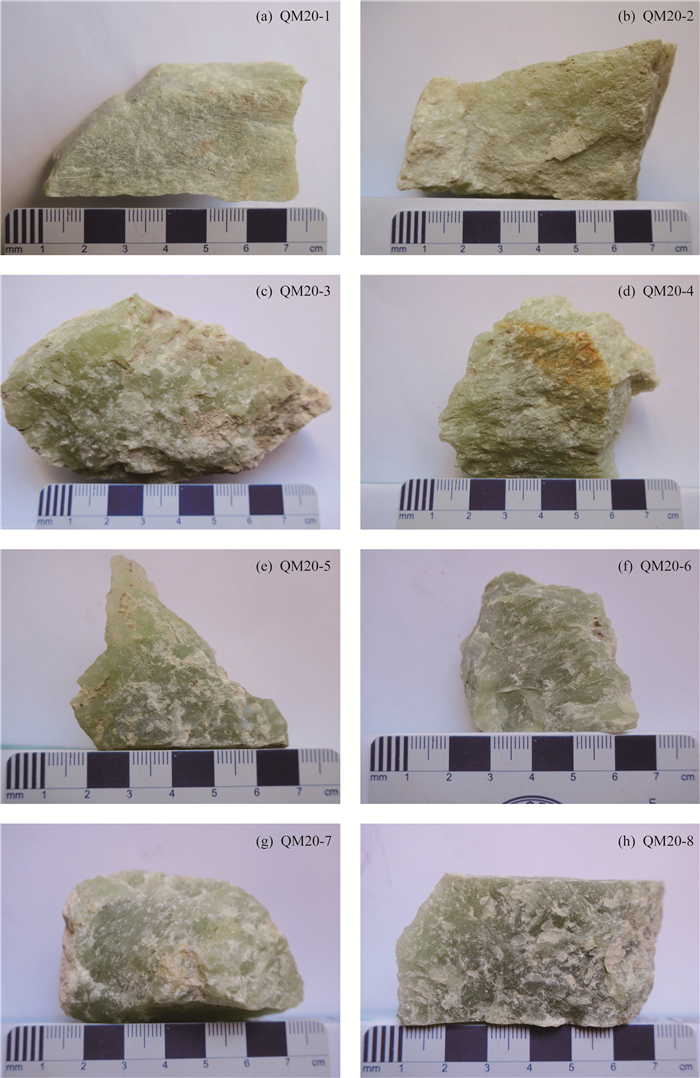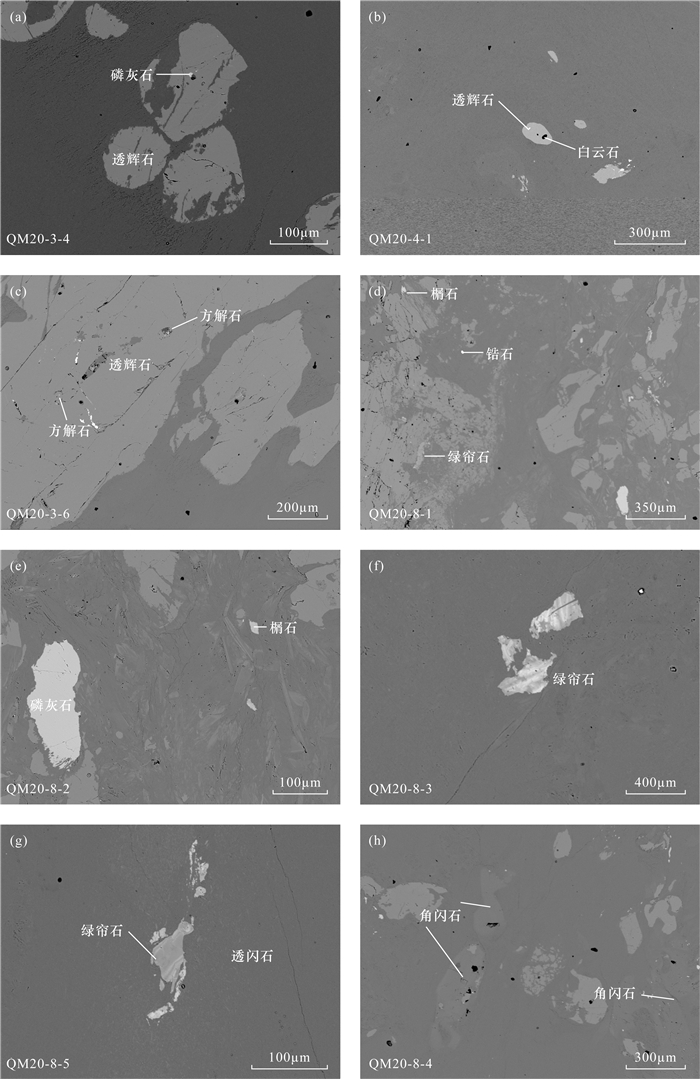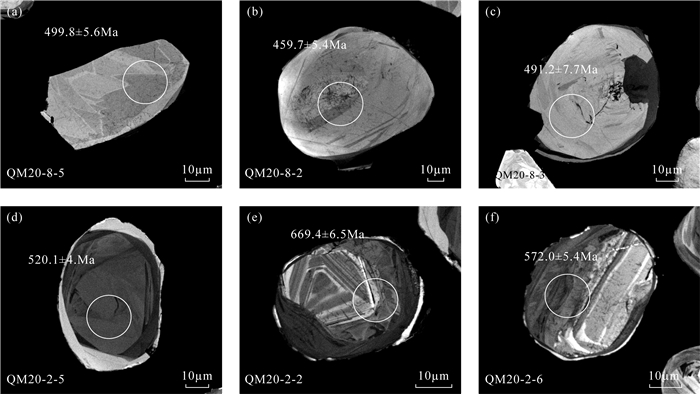Characterization of Yellow-Green Hetian Jade in Qiemo—Ruoqiang, Xinjiang
-
摘要:
新疆且末—若羌一带的和田玉,以带有黄绿色调为特征,针对该种和田玉的颜色成因和特性表征研究较少,影响了对这种和田玉的颜色和矿床成因的认识。本文利用电子探针(EPMA)、背散射电子图像(BSE)、X射线荧光光谱(XRF)、高分辨电感耦合等离子体质谱(HR-ICP-MS)分析技术对且末黄口料的矿物组成和化学成分进行测试,采用滴定法测试FeO含量,探究其颜色成因和成矿类型,并采用锆石SHRIMP U-Pb同位素定年约束其成矿时代。结果表明:该地区和田玉主要由磷灰石、方解石、白云石、透辉石、绿帘石、榍石和锆石组成。其稀土总量低(∑REE=2.61~19.1μg/g),稀土配分模式呈现出明显Eu负异常(δ Eu < 0.05)、LREE右倾、HREE平坦,根据稀土配分模式和Cr、Ni元素含量,推测是一种镁质矽卡岩型和田玉。且末黄口料和田玉Fe3+/Fe2+平均值(0.16)与其他地区和田玉有重叠,但该比值稍高(0.07~0.26),而Fe3+、Fe2+含量与其他地区和田玉之间差异并不明显。因此,推测且末—若羌和田玉的颜色成因与Fe3+/Fe2+比值有关,与Fe3+、Fe2+含量并无明显关系; 该地区和田玉中锆石SHRIMP U-Pb同位素定年获得的两个加权平均年龄为461.7±6.1Ma (MSWD=1.6)和498.1±4.6Ma (MSWD=1.16),代表了该地区黄绿色和田玉的形成时代,并可以进一步约束西昆仑的构造演化。
Abstract:BACKGROUND The Hetian nephrite belt in Xinjiang is the largest nephrite ore belt in the world, with a length of about 1300km. In addition to white, gray, black and brown nephrite, the Qiemo—Ruoqiang zone, Xinjiang also produces a yellow-green nephrite. There are few studies on the color origin and characterization of this kind of Hetian nephrite, which affects the understanding of the color and genesis of this kind of Hetian nephrite.
OBJECTIVES To understand the color genesis, genetic types and formation age of the yellow-green nephrite in Qiemo—Ruoqiang deposit.
METHODS Electron probe microanalysis (EPMA), backscattered electron (BSE) image, X-ray fluorescencespectrometry (XRF), and high resolution inductively coupled plasma-mass spectrometry (HR-ICP-MS) were used to investigate mineral and chemical composition. The FeO content was determined by titration method to explore its color origin and genetic type, and the zircon U-Pb isotope dating by sensitive high-resolution ion microprobe (SHRIMP) was used to constrain its mineralization age.
RESULTS Yellow-green nephrite in Qiemo—Ruoqiang was predominately composed of apatite, calcite, dolomite, diopside, epidote, sphene and zircon. The yellow-green nephrite whole rock had low total REE (∑REE=2.61-19.1μg/g) with obvious Eu negative anomaly (δEu < 0.05), LREE right dipping, and HREE flat pattern. According to the distribution pattern of rare earth and the content of Cr and Ni, it was inferred that it was a magnesia skarn type Hetian nephrite. Compared with other nephrite in the world, the average value of Fe3+/Fe2+ of the yellow-green nephrite in Qiemo—Ruoqiang (average=0.16) overlapped with nephrite in other regions. The ratio is slightly higher (0.07-0.26), while the content of Fe3+ and Fe2+ was not significantly different between the yellow-green nephrite and other color nephrite. The SHRIMP U-Pb dating of zircon in the yellow-green nephrite yielded ages of 461.7±6.1Ma (MSWD=1.6) and 498.1±4.6Ma (MSWD=1.16).
CONCLUSIONS The color genesis of the yellow-green nephrite in Qiemo is probably related to the ratio of Fe3+/Fe2+, but not to the content of Fe3+ and Fe2+. The SHRIMP U-Pb dating results of zircon in yellow-green nephrite represent the formation age of the yellow-green nephrite. These new data provide geochronological constraints for the magmatism of Hetian nephrite belt and the tectonic evolution of the West Kunlun orogenic belt.
-

-
表 1 且末—若羌地区黄绿色和田玉中的透闪石化学成分EPMA分析结果
Table 1. Chemical composition measured by EPMA of tremolite in the yellow-green nephrite from Qiemo—Ruoqiang area
成分 QM20-4-2-12 QM20-4-2-13 QM20-4-2-14 QM20-8-9 QM20-8-12 QM20-2-1 QM20-2-2 QM20-11-6 QM20-3-1-18 QM20-8-5 QM20-11-5 SiO2 58.31 58.02 57.86 58.43 59.24 57.98 56.06 57.45 55.10 55.74 56.98 TiO2 0.04 0.03 0.00 0.04 0.06 0.06 0.01 0.05 0.12 0.07 0.03 Al2O3 0.78 0.87 0.68 0.79 0.10 0.05 0.58 0.66 2.36 1.11 0.66 Cr2O3 0.10 0.00 0.01 0.05 0.00 0.00 0.02 0.00 0.03 0.00 0.01 FeO 0.16 0.27 0.37 0.73 0.13 0.14 0.08 1.79 0.08 5.30 1.86 MnO 0.00 0.01 0.00 0.07 0.00 0.02 0.00 0.13 0.00 0.01 0.12 MgO 23.76 23.69 23.46 23.36 24.39 23.97 23.84 22.43 23.38 20.42 22.15 CaO 12.70 12.47 12.92 13.02 13.05 13.09 13.07 13.36 13.27 12.98 13.24 Na2O 0.15 0.16 0.09 0.15 0.04 0.02 0.26 0.08 0.86 0.17 0.12 K2O 0.07 0.09 0.16 0.05 0.04 0.03 0.07 0.05 0.23 0.04 0.05 NiO 0.01 0.00 0.01 0.01 0.02 0.00 0.03 0.02 0.06 0.00 0.00 总和 96.18 95.61 95.56 96.75 97.07 95.35 94.04 96.00 95.52 95.84 95.23 TSi 8.01 8.00 8.01 8.00 8.05 8.03 7.91 7.98 7.69 7.89 7.98 TAl 0.00 0.00 0.00 0.00 0.00 0.00 0.09 0.02 0.31 0.11 0.02 T位阳离子数 8.01 8.00 8.01 8.00 8.05 8.03 8.00 8.00 8.00 8.00 8.00 CAl 0.13 0.14 0.11 0.13 0.02 0.01 0.01 0.09 0.08 0.07 0.09 CFe3+ 0.00 0.00 0.04 0.08 0.01 0.02 0.00 0.21 0.01 0.59 0.22 CCr 0.01 0.00 0.00 0.00 0.00 0.00 0.00 0.00 0.00 0.00 0.00 CMg 4.86 4.86 4.84 4.77 4.94 4.95 5.00 4.64 4.87 4.31 4.62 CFe2+ 0.00 0.00 0.00 0.00 0.00 0.00 0.00 0.00 0.00 0.00 0.00 CMn 0.00 0.00 0.00 0.01 0.00 0.00 0.00 0.02 0.00 0.00 0.01 C位阳离子数 5.00 5.00 4.99 4.99 5.00 4.98 5.01 4.96 4.96 5.00 4.94 BMg 0.00 0.01 0.00 0.00 0.00 0.00 0.01 0.00 0.00 0.00 0.00 BFe2+ 0.02 0.03 0.00 0.00 0.00 0.00 0.01 0.00 0.00 0.04 0.00 BMn 0.00 0.00 0.00 0.00 0.00 0.00 0.00 0.00 0.00 0.00 0.00 BCa 1.87 1.84 1.92 1.91 1.90 1.94 1.98 1.99 1.99 1.96 1.99 BNa 0.04 0.04 0.02 0.04 0.01 0.01 0.00 0.01 0.01 0.00 0.01 B位阳离子数 1.93 1.92 1.94 1.95 1.91 1.95 2.00 2.00 2.00 2.00 2.00 ACa 0.00 0.00 0.00 0.00 0.00 0.00 0.00 0.00 0.00 0.01 0.00 ANa 0.00 0.00 0.00 0.00 0.00 0.00 0.07 0.01 0.22 0.05 0.02 AK 0.01 0.02 0.03 0.01 0.01 0.01 0.01 0.01 0.04 0.01 0.01 A位阳离子数 0.01 0.02 0.03 0.01 0.01 0.01 0.08 0.02 0.26 0.07 0.03 阳离子总和 14.95 14.94 14.97 14.95 14.97 14.97 15.09 14.98 15.22 15.07 14.97 Mg/(Mg2++Fe2+) 1.00 0.99 0.99 0.98 1.00 1.00 1.00 0.96 1.00 0.87 0.95 注:数据单位为%。 表 2 且末—若羌地区黄绿色和田玉中的次要矿物组成电子探针(EPMA)分析结果
Table 2. Compositions measured by EPMA of associate minerals in the yellow-green nephrite from Qiemo—Ruoqiang area
元素 角闪石(%) 透辉石(%) 绿帘石(%) QM20-8-7 QM20-8-8 QM20-8-10 QM20-4-1-1 QM20-3-1-1 QM20-3-1-4 QM20-3-1-9 QM20-3-1-14 QM20-11-1 QM20-8-11 QM20-8-3 SiO2 45.69 43.27 47.16 55.27 54.99 55.00 54.94 55.16 55.36 38.72 38.47 TiO2 0.42 0.61 0.59 0.00 0.02 0.04 0.03 0.08 0.05 0.59 0.08 Al2O3 14.10 15.02 11.67 0.18 0.36 0.26 0.28 0.24 1.63 28.71 28.18 Cr2O3 0.08 0.00 0.31 0.00 0.00 0.00 0.03 0.00 0.02 0.05 0.00 FeO 0.52 0.71 0.50 0.02 0.02 0.06 0.11 0.06 1.65 3.43 5.45 MnO 0.05 0.01 0.00 0.02 0.00 0.00 0.06 0.00 0.08 0.06 0.05 MgO 19.63 19.13 20.70 18.16 18.25 18.35 18.98 18.12 16.12 0.55 0.10 CaO 12.91 13.03 13.03 25.31 25.36 25.19 23.88 25.24 24.11 23.48 23.46 Na2O 2.11 2.21 2.14 0.10 0.14 0.14 0.09 0.10 0.43 0.02 0.00 K2O 1.48 1.60 1.05 0.00 0.00 0.00 0.03 0.00 0.00 0.01 0.00 NiO 0.01 0.00 0.02 0.01 0.03 0.08 0.03 0.00 0.00 0.02 0.00 总和 97.00 95.59 97.17 99.07 99.17 99.12 98.46 99.00 99.45 95.64 95.79 Si 6.43 6.22 6.61 2.01 2.00 2.00 2.00 2.01 2.01 3.04 3.03 Al 2.34 2.54 1.93 0.01 0.02 0.01 0.01 0.01 0.07 2.65 2.61 Mg 4.11 4.09 4.32 0.98 0.99 1.00 1.03 0.98 0.87 0.06 0.01 TFe 0.06 0.09 0.06 0.00 0.00 0.00 0.00 0.00 0.05 0.23 0.36 Ca 1.94 2.00 1.95 0.98 0.99 0.98 0.93 0.98 0.94 1.98 1.98 Na 0.58 0.62 0.58 0.01 0.01 0.01 0.01 0.01 0.03 0.00 0.00 K 0.27 0.29 0.19 0.00 0.00 0.00 0.00 0.00 0.00 0.00 0.00 总和 15.73 15.85 15.64 3.99 4.01 4.00 3.98 3.99 3.97 7.96 7.99 表 3 且末—若羌地区黄绿色和田玉中的全岩主微量XRF和HR-ICP-MS分析结果
Table 3. Analytical results of major and trace elements measured by XRF and HR-ICP-MS in the yellow-green nephrite from Qiemo—Ruoqiang area
主量元素 含量(%) QM20-1 QM20-2 QM20-3 QM20-4 QM20-7 QM20-8 SiO2 57.76 57.63 56.93 58.06 57.54 56.16 TiO2 0.01 0.02 <0.01 0.01 <0.01 0.12 Al2O3 0.91 0.48 0.71 0.90 0.96 1.01 Cr2O3 0.01 0.02 0.01 0.02 0.02 0.01 Fe2O3 0.02 0.04 <0.01 0.04 0.02 0.09 FeO 0.24 0.22 0.18 0.20 0.37 0.94 MnO 0.03 0.03 0.03 0.03 0.04 0.06 MgO 24.50 24.10 23.20 24.70 24.10 22.10 CaO 13.10 14.20 15.15 12.95 14.25 16.35 Na2O 0.26 0.26 0.23 0.25 0.23 0.23 K2O 0.17 0.08 0.06 0.12 0.06 0.08 P2O5 0.01 0.01 <0.01 <0.01 0.01 0.03 LOI 2.98 3.22 3.18 3.66 2.81 2.61 总和 100.00 100.31 99.68 100.94 100.41 99.79 Fe3+/Fe2+ 0.11 0.23 低于检测限 0.26 0.07 0.12 微量元素 含量(μg/g) QM20-1 QM20-2 QM20-3 QM20-4 QM20-7 QM20-8 Cr 3.00 3.00 2.00 3.00 2.00 5.00 Ni 1.20 1.20 0.90 1.40 1.00 3.80 Rb 16.0 2.70 2.80 11.6 1.70 4.90 Ba 7.80 5.10 18.7 15.4 9.20 13.9 Th 0.22 0.12 0.12 0.17 0.59 0.73 U 1.01 0.47 0.94 0.87 0.57 0.83 Nb 0.40 0.30 0.10 0.30 0.20 3.00 Ta <0.05 0.10 <0.05 0.05 0.06 0.21 La 0.80 0.60 0.60 1.00 <0.50 2.80 Ce 1.81 1.41 1.23 2.01 0.75 6.53 Pr 0.21 0.17 0.14 0.22 0.09 0.84 Sr 12.3 10.1 16.5 14.1 8.50 24.9 Nd 0.90 0.70 0.50 0.80 0.40 3.40 Zr 4.00 4.00 <2.00 3.00 3.00 17.0 Hf 0.10 0.10 <0.10 0.10 0.10 0.50 Sm 0.19 0.16 0.11 0.14 0.09 0.83 Eu <0.03 <0.03 <0.03 <0.03 <0.03 0.11 Gd 0.20 0.16 0.13 0.14 0.14 0.97 Tb 0.03 0.03 0.02 0.02 0.03 0.18 Dy 0.21 0.17 0.15 0.15 0.20 1.23 Y 1.40 1.10 1.30 1.20 1.90 7.20 Ho 0.04 0.04 0.03 0.04 0.05 0.27 Er 0.13 0.11 0.11 0.10 0.16 0.83 Tm 0.02 0.02 0.02 0.01 0.02 0.13 Yb 0.11 0.13 0.09 0.07 0.13 0.83 Lu 0.02 0.02 0.01 0.01 0.02 0.13 Li 12.8 7.20 7.40 9.20 9.90 14.3 Be 16.2 6.10 9.31 14.6 9.67 18.3 Mn 204 181 197 216 254 390 Co 1.60 1.70 1.70 1.60 4.60 5.70 Cu 2.50 5.00 3.10 3.00 2.50 6.20 Zn 106 72.0 119 113 102 96.0 Ga 2.44 2.09 2.01 1.84 2.02 2.54 Cu 2.50 5.00 3.10 3.00 2.50 6.20 Zn 106 72.0 119 113 102 96.0 Ga 2.44 2.09 2.01 1.84 2.02 2.54 Mo <0.05 0.14 <0.05 0.05 <0.05 <0.05 Cd 0.03 0.04 0.03 0.04 0.03 0.04 In 0.01 <0.005 <0.005 <0.005 <0.005 0.04 Cs 2.27 0.20 0.71 2.17 0.65 0.65 Tl 0.11 0.04 0.03 0.09 <0.02 0.04 Pb 3.20 1.40 2.70 2.20 2.30 1.70 Bi 0.01 0.01 0.03 0.02 0.02 0.09 Sn 1.00 1.00 0.20 0.80 0.20 1.80 Sb 0.36 0.20 0.82 0.63 0.51 0.44 Ti 0.01 0.02 0.01 0.01 0.01 0.07 W 0.60 0.20 0.80 1.30 1.10 0.70 As 3.60 4.20 5.60 2.40 3.00 3.10 V 29.0 27.0 15.0 29.0 23.0 36.0 Sc 0.50 0.60 0.20 0.20 0.20 3.70 LREE 3.94 3.07 2.61 4.20 1.86 14.5 HREE 0.76 0.68 0.56 0.54 0.75 4.57 ∑REE 4.70 3.75 3.17 4.74 2.61 19.1 表 4 且末—若羌地区黄绿色和田玉中锆石SHRIMP U-Pb年龄
Table 4. SHRIMP U-Pb zircon ages of the yellow-green nephrite from Qiemo—Ruoqiang area
测点号 206Pbc
(%)U
(μg/g)Th
(μg/g)232Th/238U 206Pb*
(μg/g)Th/U 207Pb*/206Pb* 207Pb*/235U 206Pb*/238U 206 Pb/238U
年龄(Ma)QM20-2-1 0.04 656 7 0.01 45.6 0.01 0.0568±0.99 0.6340±1.4 0.0809±1.4 501.4±4.7 QM20-2-2 0.07 436 36 0.08 41.0 0.08 0.0648±1.1 0.9770±1.5 0.1094±1.4 669.4±6.5 QM20-2-3 0.02 470 69 0.15 49.9 0.15 0.0706±0.01 1.203±1.3 0.1235±1.4 750.9±6.8 QM20-2-4 0.03 518 7 0.01 36.8 0.01 0.0564±1.1 0.6432±1.5 0.0827±1.4 512.3±4.7 QM20-2-5 0.00 590 8 0.01 42.6 0.01 0.0573±0.96 0.6643±1.3 0.0840±1.4 520.1±4.7 QM20-2-6 0.05 547 70 0.13 43.6 0.13 0.0689±0.97 0.8810±1.4 0.0928±1.4 572.0±5.4 QM20-2-7 0.04 564 141 0.26 73.9 0.26 0.0731±0.68 1.536±1.2 0.1525±1.4 914.7±8.1 QM20-2-8 0.00 511 274 0.55 112 0.55 0.1019±0.58 3.592±1.1 0.2558±1.4 1468±12 QM20-2-9 0.04 661 643 1.01 70.6 1.01 0.0684±0.67 1.173±1.2 0.1244±1.4 755.7±6.7 QM20-2-10 0.03 548 28 0.05 91.5 0.05 0.0998±0.53 2.673±1.2 0.1942±1.4 1144±11 QM20-8-1 0.15 191 15 0.08 12.4 0.08 0.0562±2.0 0.5840±2.3 0.0754±1.1 468.3±5.0 QM20-8-2 0.35 116 31 0.28 7.40 0.28 0.0551±3.5 0.5620±3.7 0.0739±1.2 459.7±5.4 QM20-8-3 0.34 123 13 0.11 8.40 0.11 0.0576±3.5 0.6290±3.9 0.0792±1.6 491.2±7.7 QM20-8-4 0.21 116 10 0.09 8.10 0.09 0.0560±2.6 0.6270±2.9 0.0813±1.2 503.7±5.9 QM20-8-5 0.16 154 15 0.10 10.7 0.10 0.0588±2.5 0.6530±2.7 0.0806±1.2 499.8±5.6 QM20-8-6 0.22 109 7 0.07 7.40 0.07 0.0556±3.7 0.6070±4.0 0.0792±1.5 491.3±7.3 QM20-8-7 0.07 201 12 0.06 14.1 0.06 0.0574±2.0 0.6460±2.3 0.0817±1.1 506.2±5.5 QM20-8-8 0.26 104 11 0.11 7.00 0.11 0.0568±3.1 0.6170±3.4 0.0788±1.3 489.2±6.2 QM20-8-9 0.28 154 46 0.31 9.70 0.31 0.0555±3.2 0.5600±3.4 0.0732±1.3 455.6±5.6 QM20-8-10 0.00 165 20 0.13 11.4 0.13 0.0568±2.0 0.6280±2.3 0.0802±1.2 497.4±5.6 注:206Pbc和206Pb*分别表示普通铅和放射成因铅, 普通铅根据实测204Pb进行校正,误差为1σ。 -
[1] Gil G, Barnes J D, Boschi C, et al. Origin of serpentinite-related nephrite from Jordanów and adjacent areas (SW Poland) and its comparison with selected nephrite occurrences[J]. Geological Quarterly, 2015, 59(3): 457-472.
[2] Korybska-Sadło I, Gil G, Gunia P, et al. Raman and FTIR spectra of nephrites from the Złoty Stok and Jordanów Slski (the Sudetes and Fore-Sudetic Block, SW Poland)[J]. Journal of Molecular Structure, 2018, 1166: 40-47. doi: 10.1016/j.molstruc.2018.04.020
[3] Grapes R H, Yun S T. Geochemistry of a New Zealand nephrite weathering rind[J]. New Zealand Journal of Geology and Geophysics, 2010, 53: 413-426. doi: 10.1080/00288306.2010.514929
[4] Liu Y, Deng J, Shi G H, et al. Chemical zone of nephrite in Alamas, Xinjiang, China[J]. Resource Geology, 2010, 60: 249-259. doi: 10.1111/j.1751-3928.2010.00135.x
[5] Liu Y, Deng J, Shi G H, et al. Geochemistry and petrogenesis of placer nephrite from Hetian, Xinjiang, northwest China[J]. Ore Geology Reviews, 2011, 41: 122-132. doi: 10.1016/j.oregeorev.2011.07.004
[6] Liu Y, Deng J, Shi G H, et al. Geochemistry and petrology of nephrite from Alamas, Xinjiang, NW China[J]. Journal of Asian Earth Sciences, 2011, 42: 440-451. doi: 10.1016/j.jseaes.2011.05.012
[7] Liu Y, Zhang R, Abuduwayiti M, et al. SHRIMP U-Pb zircon ages, mineral compositions and geochemistry of placer nephrite in the Yurungkash and Karakash River deposits, West Kunlun, Xinjiang, northwest China: Implication for a Magnesium skarn[J]. Ore Geology Reviews, 2016, 72: 699-727. doi: 10.1016/j.oregeorev.2015.08.023
[8] Liu Y, Zhang R, Zhang Z, et al. Mineral inclusions and SHRIMP U-Pb dating of zircons from the Alamas nephrite and granodiorite: Implications for the genesis of a magnesian skarn deposit[J]. Lithos, 2015, 212-215: 128-144. doi: 10.1016/j.lithos.2014.11.002
[9] Liu X F, Gil G, Liu Y, et al. Timing of formation and cause of coloration of brown nephrite from the Tiantai Deposit, South Altyn Tagh, northwestern China[J]. Ore Geology Reviews, 2021, 131: 103972. doi: 10.1016/j.oregeorev.2020.103972
[10] 刘喜锋, 刘琰, 李自静, 等. 新疆皮山镁质矽卡岩矿床(含糖玉)成因及锆石SHRIMP U-Pb定年[J]. 岩石矿物学杂志, 2017, 36(2): 259-273. https://www.cnki.com.cn/Article/CJFDTOTAL-YSKW201702010.htm
Liu X F, Liu Y, Li Z J, et al. The genesis of Mg-skarn deposit (bearing brown nephrite) and its Ar-Ar dating of phlogopite and SHRIMP U-Pb dating of zircon, Pishan, Xinjiang[J]. Acta Petrologica et Mineralogica, 2017, 36(2): 259-273. https://www.cnki.com.cn/Article/CJFDTOTAL-YSKW201702010.htm
[11] 张勇, 魏华, 陆太进, 等. 新疆奥米夏和田玉矿床成因及锆石LA-ICP-MS定年研究[J]. 岩矿测试, 2018, 37(6): 695-704. http://www.ykcs.ac.cn/cn/article/doi/10.15898/j.cnki.11-2131/td.201801170007
Zhang Y, Wei H, Lu T J, et al. The genesis and LA-ICP-MS zircon ages of Omixia nephrite deposit, Xinjiang, China[J]. Rock and Mineral Analysis, 2018, 37(6): 695-704. http://www.ykcs.ac.cn/cn/article/doi/10.15898/j.cnki.11-2131/td.201801170007
[12] 刘喜锋, 张红清, 刘琰, 等. 世界范围内代表性碧玉的矿物特征和成因研究[J]. 岩矿测试, 2018, 37(5): 479-489. http://www.ykcs.ac.cn/cn/article/doi/10.15898/j.cnki.11-2131/td.201712010187
Liu X F, Zhang H Q, Liu Y, et al. Mineralogical characteristics and genesis of green nephrite from the world[J]. Rock and Mineral Analysis, 2018, 37(5): 479-489. http://www.ykcs.ac.cn/cn/article/doi/10.15898/j.cnki.11-2131/td.201712010187
[13] Gao K, Shi G H, Wang M L, et al. The Tashisayi nephrite deposit from South Altyn Tagh, Xinjiang, northwest China[J]. Geoscience Frontiers, 2019, 10(4): 1597-1612. doi: 10.1016/j.gsf.2018.10.008
[14] Harlow G E, Sorensen S S. Jade (nephrite and jadeitite) and serpentinite: Metasomatic connections[J]. International Geology Review, 2005, 47: 113-146. doi: 10.2747/0020-6814.47.2.113
[15] Burtseva M V, Ripp G S, Posokhov V F, et al. Nephrites of East Siberia: Geochemical features and problems of genesis[J]. Russian Geology & Geophysics, 2015, 56(3): 402-410.
[16] Adamo I, Bocchio R. Nephrite jade from Val Malenco, Italy: Review and update[J]. Gems & Gemology, 2013, 49(2): 98-106.
[17] 刘喜锋, 贾玉衡, 刘琰. 新疆若羌—且末戈壁料软玉的地球化学特征及成因类型研究[J]. 岩矿测试, 2019, 38(3): 316-325. http://www.ykcs.ac.cn/cn/article/doi/10.15898/j.cnki.11-2131/td.201806180072
Liu X F, Jia Y H, Liu Y. Geochemical characteristics and genetic types of Gobi nephrite in Ruoqiang—Qiemo, Xinjiang[J]. Rock and Mineral Analysis, 2019, 38(3): 316-325. http://www.ykcs.ac.cn/cn/article/doi/10.15898/j.cnki.11-2131/td.201806180072
[18] Gao S, Bai F, Heide G. Mineralogy, geochemistry and petrogenesis of nephrite from Tieli, China[J]. Ore Geology Reviews, 2019, 107(5): 155.
[19] Bai F, Du J M, Li J J, et al. Mineralogy, geochemistry and petrogenesis of green nephrite from Dahua, Guangxi, southern China[J]. Ore Geology Reviews, 2020, 118: 103362. doi: 10.1016/j.oregeorev.2020.103362
[20] Bai F, Li G, Lei J, et al. Mineralogy, geochemistry and petrogenesis of nephrite from Panshi, Jilin, northeast China[J]. Ore Geology Reviews, 2019, 115: 103171. doi: 10.1016/j.oregeorev.2019.103171
[21] Siqin B, Qian R, Zhuo S, et al. Glow discharge mass spectrometry studies on nephrite minerals formed by different metallogenic mechanisms and geological environments[J]. International Journal of Mass Spectrometry, 2012, 309: 206-211. doi: 10.1016/j.ijms.2011.10.003
[22] Kostov R I, Protochristov C, Stoyanov C, et al. Micro-PIXE geochemical fingerprinting of nephrite Neolithic artifacts from southwest Bulgaria[J]. Geoarchaeology, 2012, 27: 457-469. doi: 10.1002/gea.21417
-




 下载:
下载:




